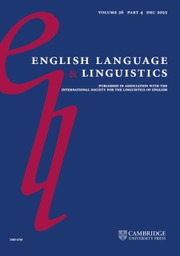No CrossRef data available.
Article contents
Wiebke H. Ahlers, Consonantal sound change in American English: An analysis of clustered sibilants (Studies in English Language). Cambridge: Cambridge University Press, 2023. Pp. xii + 233. ISBN 9781316512722.
Review products
Wiebke H. Ahlers, Consonantal sound change in American English: An analysis of clustered sibilants (Studies in English Language). Cambridge: Cambridge University Press, 2023. Pp. xii + 233. ISBN 9781316512722.
Published online by Cambridge University Press: 02 October 2024
Abstract
An abstract is not available for this content so a preview has been provided. Please use the Get access link above for information on how to access this content.

- Type
- Book Review
- Information
- Copyright
- Copyright © The Author(s), 2024. Published by Cambridge University Press
References
Ahlers, Wiebke. 2020. Palatalization in Austin: A sociophonetic analysis of sibilants. PhD dissertation, Universität Osnabrück.Google Scholar
Baker, Adam, Archangeli, Diana & Mielke, Jeff. 2011. Variability in American English s-retraction suggests a solution to the actuation problem. Language Variation and Change 23, 347–74.CrossRefGoogle Scholar
Bell, Allan. 1984. Language style as audience design. Language in Society 13, 145–204.10.1017/S004740450001037XCrossRefGoogle Scholar
Delattre, Pierre & Freeman, Donald C.. 1968. A dialect study of American r's by x-ray motion picture. Linguistics 44, 29–68.Google Scholar
Docherty Gerard, J. & Foulkes, Paul. 1999. Derby and Newcastle: Instrumental phonetics and variationist studies. In Foulkes, Paul & Docherty, Gerard J. (eds.), Urban voices: Accent studies in the British Isles, 47–71. London: Arnold.Google Scholar
Espy-Wilson, Carol Y., Boyce, Suzanne E., Jackson, Michael, Narayanan, Shrikanth & Alwan, Abeer. 2000. Acoustic modeling of American English /r/. Journal of the Acoustical Society of America 108, 343–56.10.1121/1.429469CrossRefGoogle ScholarPubMed
Harris, Maverick Marvin. 1969. The retroflexion of postvocalic /r/ in Austin. American Speech 44, 263–71.CrossRefGoogle Scholar
Kerswill, Paul & Wright, Susan. 1990. The validity of phonetic transcription: Limitations of a sociolinguistic research tool. Language Variation and Change 2, 255–75.CrossRefGoogle Scholar
Labov, William. 1972. Sociolinguistic patterns. Philadelphia: University of Pennsylvania Press.Google Scholar
Labov, William. 2001. Principles of linguistic change, vol. 2: Social factors. Oxford and Malden, MA: Blackwell.Google Scholar
Ladefoged, Peter & Maddieson, Ian. 1996. The sounds of the world's languages. Oxford and Malden, MA: Blackwell.Google Scholar
McDowell, John & McRae, Susan. 1972. Differential response of the class and ethnic components of the Austin speech community. Anthropological Linguistics 14, 228–39.Google Scholar
Mielke, Jeff, Baker, Adam & Archangeli, Diana. 2016. Individual-level contact limits phonological complexity: Evidence from bunched and retroflex /ɹ/. Language 92, 101–40.CrossRefGoogle Scholar
Purnell, Thomas, Salmons, Joseph & Tepeli, Dilara. 2005. German substrate effects in Wisconsin English: Evidence for final fortition. American Speech 80, 135–64.CrossRefGoogle Scholar
Silverstein, Michael. 2003. Indexical order and the dialectics of sociolinguistic life. Language and Communication 23, 193–229.CrossRefGoogle Scholar
Tamminga, Meredith. 2014. Sound change without frequency effects: Ramifications for phonological theory. In Santana-LaBarge, Robert E. (ed.), Proceedings of the 31st West Coast Conference on Formal Linguistics, 457–65. Somerville, MA: Cascadilla Proceedings Project.Google Scholar
Weinreich, Uriel, Labov, William & Herzog, Marvin. 1968. Empirical foundations for a theory of language change. In Lehmann, Winfred P. & Malkiel, Yakov (eds.), Directions for historical linguistics: A symposium, 95–188. Austin: University of Texas Press.Google Scholar



